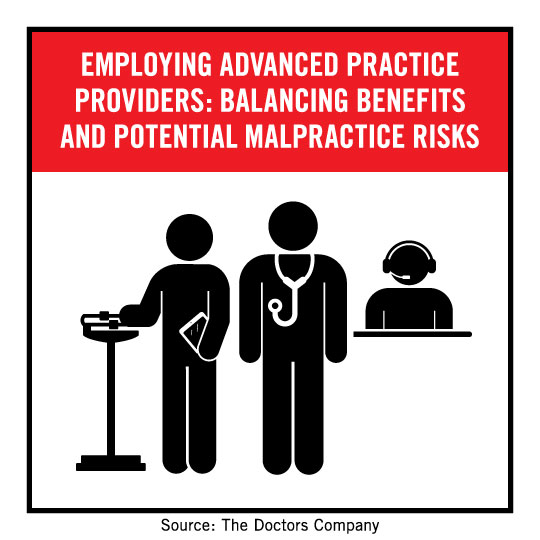Employing Advanced Practice Providers: Balancing Benefits and Potential Malpractice Risks
Risk Tip | Practices and hospitals that employ advanced practice providers (APPs), including nurse practitioners and physician assistants, can experience many benefits, such as lower operating overhead, increased physician time with patients, and improved patient education and satisfaction. However, employers of APPs should consider implementing effective risk management measures to help ensure that the benefits of using APPs are not at the expense of increased liability exposure.
|
|
An APP is often covered under the physician’s or hospital’s malpractice insurance policy under vicarious liability coverage. APPs can be held directly liable for their own acts or omissions, but, in addition, under the legal theory of vicarious liability, physicians and hospitals can also be held liable for the actions of their employees, including APPs. Therefore, the physician or hospital is often named in malpractice claims involving their APPs.
To help decrease liability risks, the employing physician or hospital should have a written policy outlining the APP’s scope of practice. This policy should be signed by the APP and other staff members annually. In putting together this policy, it is important to know the laws in your state that govern the scope of practice of APPs. Other suggestions to decrease liability risks include:
- Ensure that all newly hired APPs undergo orientation with the practice or hospital.
- When scheduling appointments, staff should inform patients when they are being scheduled with an APP. If that patient requests to see his or her physician, the staff should provide the patient with that option.
- Make certain APPs wear identification that indicates their name and their job title.
- Develop treatment guidelines and clinical triggers for physician consultation. Meet with the APPs regularly to discuss their roles and expectations within the practice, and document these meetings.
- Regularly review the charts, including prescription monitoring, of patients seen by the APPs.
- Make sure that all staff members, including APPs, have adequate professional liability coverage. For nonemployed APPs, liability coverage should be equal to what the physician or practice carries.
To read case studies about employing APPs and for detailed risk management checklists, download The Doctors Company’s guide to an APP preventive action and loss prevention plan by clicking here.
Article written by Kathleen Moon, ARNP, LHRM, Patient Safety Risk Manager, The Doctors Company. Contributed by The Doctors Company. For more patient safety articles and practice tips, visit www.thedoctors.com/patientsafety.

